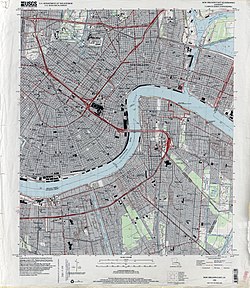
The French Quarter, also known as the Vieux Carré, is the oldest neighborhood in the city of New Orleans. After New Orleans was founded in 1718 by Jean-Baptiste Le Moyne de Bienville, the city developed around the Vieux Carré, a central square. The district is more commonly called the French Quarter today, or simply "The Quarter," related to changes in the city with American immigration after the 1803 Louisiana Purchase. Most of the extant historic buildings were constructed either in the late 18th century, during the city's period of Spanish rule, or were built during the first half of the 19th century, after U.S. annexation and statehood.
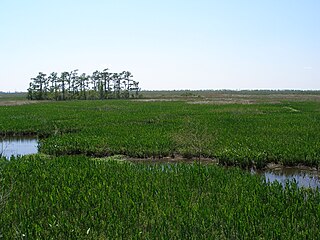
Jean Lafitte National Historical Park and Preserve protects the natural and cultural resources of Louisiana's Mississippi River Delta region. It is named after French pirate Jean Lafitte and consists of six separate sites and a park headquarters.

The New Orleans Cotton Exchange was established in New Orleans, Louisiana, in 1871 as a centralized forum for the trade of cotton. It operated in New Orleans until closing in 1964. Occupying several buildings over its history, its final location, the New Orleans Cotton Exchange Building, is now a National Historic Landmark.

Jackson Square is a historic park in the French Quarter of New Orleans, Louisiana. It was declared a National Historic Landmark in 1960, for its central role in the city's history, and as the site where in 1803 Louisiana was made United States territory pursuant to the Louisiana Purchase. In 2012 the American Planning Association designated Jackson Square as one of the Great Public Spaces in the United States.

Gallier Hall is a historic building on St. Charles Avenue in New Orleans, Louisiana. It is the former New Orleans city hall, and continues in civic use. Built 1845–1853, it is a nationally significant example of Greek Revival architecture, and one of the finest works of architect James Gallier. It was designated a National Historic Landmark in 1974.

The Louisiana History Museum is located in the historic downtown portion of Alexandria, Louisiana, USA, near the Red River. It showcases the social evolution of all of Louisiana, but centers on the history of Central Louisiana, Rapides Parish, and Alexandria. Major exhibit areas deal with Native Americans, Louisiana geography, politics, health care, farming, and the impact of war.

The Old Louisiana State Capitol, also known as the State House, is a historic government building, and now a museum, at 100 North Boulevard in Baton Rouge, Louisiana, U.S.A.. It housed the Louisiana State Legislature from the mid-19th century until the current capitol tower building was constructed in 1929-32.
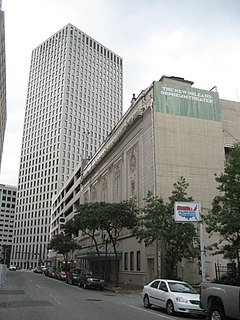
1010 Common, located at 1010 Common Street in the Central Business District of New Orleans, Louisiana, is a 31-story skyscraper. The building, designed by Skidmore, Owings & Merrill and completed in 1970, is an example of the international style typical of the time. It is located adjacent to the 14-story Latter Center Garage & Annex.

The Pentagon Barracks, also known as the Old United States Barracks, is a complex of buildings located at the corner of State Capitol Drive and River Road in Baton Rouge, Louisiana, in the grounds of the state capitol. The site was used by the Spanish, French, British, Confederate States Army, and United States Army and was part of the short-lived Republic of West Florida. During its use as a military post the site has been visited by such notable figures as Zachary Taylor, Lafayette, Robert E. Lee, George Custer, Jefferson Davis, and Abraham Lincoln.

Gallier House is a restored 19th-century historic house museum located on Royal Street in the French Quarter of New Orleans, Louisiana.

Louisiana State Bank Building is a historic commercial building at Royal and Conti Streets in the French Quarter of New Orleans, Louisiana. Built in 1820, it was the last structure designed by nationally prominent architect Benjamin Henry Latrobe, who died from yellow fever in New Orleans before its construction. It has also been known as the Manheim Galleries building, from a long-time tenant. More recently, it has housed "Latrobe's", an event venue. It was declared a National Historic Landmark in 1983.

The following properties are listed on the National Register of Historic Places in Orleans Parish, Louisiana.

This is a list of the National Register of Historic Places listings in DeSoto Parish, Louisiana.

The U.S. Custom House, also known as the Old Post Office and Custom House, is a historic government building at 423 Canal Street in New Orleans, Louisiana. It was designated a National Historic Landmark, receiving this designation in 1974 and noted for its Egyptian Revival columns. Construction on the building, designed to house multiple federal offices and store goods, began in 1848 and didn't finish until 1881 due to redesigns and the American Civil War. The U.S. Customs offices have been located there since the late 19th century.

The U.S. Post Office and Courthouse-Baton Rouge, also known as Federal Building and U.S. Courthouse, in Baton Rouge, Louisiana, was built in 1932. It includes Art Deco and Moderne architecture. It served historically as a post office, as a courthouse, and as a government office building.

Favrot & Livaudais (1891–1933) was an architectural firm in New Orleans, Louisiana. The firm designed many buildings that are listed on the National Register of Historic Places.
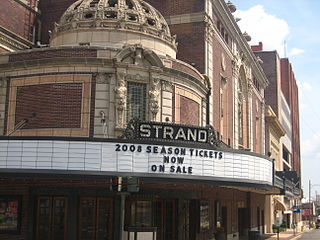
Emile Weil was a noted architect of New Orleans, Louisiana.

Poydras Street is a street that serves as the main artery of the New Orleans Central Business District, in New Orleans, Louisiana. The street is named for Julien de Lallande Poydras. Many of the city of New Orleans' and the state of Louisiana's tallest buildings have been built on the street since it was widened in the mid 1960s. The street also hosts several historic structures and is the boundary between two United States National Register of Historic Places districts.

The New Orleans Lower Central Business District is a historic district in New Orleans, Louisiana which was listed on the National Register of Historic Places (NRHP) in 1991. It may be referred to as Lower Central Business District. Along with the NRHP-listed New Orleans Upper Central Business District to the south, across the redeveloped Poydras Street, it is included within the larger New Orleans Central Business District area. To the north, between N. Peters and N. Rampart, the district borders the historic, NRHP-listed Vieux Carre, which is a U.S. National Historic Landmark.
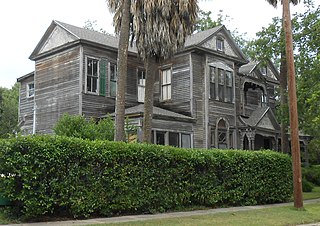
The Theodore Buhler House is a historic house in Victoria, Texas. It was built in 1890 for Theodore Buhler and his wife, Katherine Schmidt. Born in Baden, Germany, he emigrated to the United States at a young age and grew up in New Orleans, Louisiana. During the American Civil War, he worked for Cook's foundry in New Orleans, which made firearms for the Confederate States Army. In the postbellum era, he worked for the railroads and steamships in Louisiana and Texas, and he co-founded the First National Bank of Victoria, the Victoria Loan Company, and the Victoria Building and Loan Company. He died in 1912.

